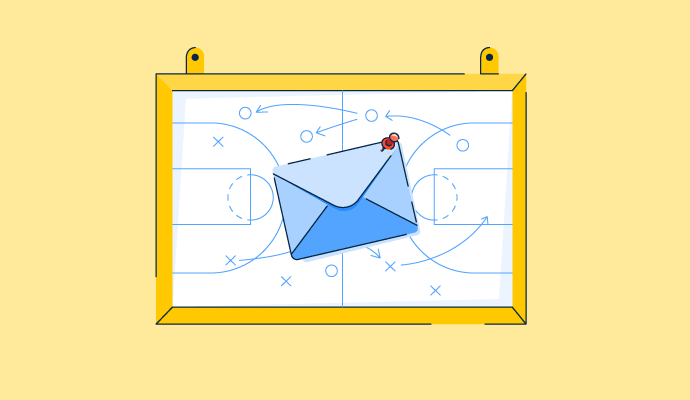What is email marketing?
Email marketing is the process of contacting prospects through email. Most companies engage in this type of direct marketing due to its high return on investment.
Email marketing takes many shapes, including one-time emails promoting a single sale item or longer sequences to nurture audiences. To gain access to email addresses and build a list, companies ask current customers to subscribe to their marketing communications at checkout or encourage potential customers to exchange their contact information for something of value, like a lead magnet or a discount code.
Most companies use email marketing software to manage their extensive email lists, segment their audiences, and automate sending emails. These platforms also allow users to see analytics like open rates, unsubscribes, and click-through rates.
Types of email marketing
Companies use email marketing in a number of ways. Companies may turn to one type for new leads while exercising a completely different approach for loyal customers.
- Newsletters: Companies send these informational emails weekly, biweekly, or monthly. They build brand awareness and show customers and leads how helpful the business is.
- Welcome sequences: When customers first subscribe to email lists, companies send them messages to let them know they’re in the right place. These emails explain how the brand and its products or services can help and how to get started.
- Nurture sequences: This is a series of emails that relay information and build interest in an offering, such as a new product bundle or program.
- Dedicated: Companies sometimes send one-off emails to promote a specific product or event. These emails have a single call-to-action (CTA).
- Cart abandonment: Some retailers set up a workflow that automatically sends a reminder email after a customer has left items in their cart for a set amount of time. These emails provide one last opportunity for a company to answer some additional questions and gently nudge the leads toward purchase.
- Re-engagement: If customers on an email list haven’t opened a company’s emails in a while or haven’t returned to make a purchase, re-engagement emails turn them into warm leads again by delivering a discount code or asking for feedback.
- Informational: These emails tell subscribers about new offers to convince them to make another purchase, upgrade their subscriptions, or increase customer activation rates. Retail companies might send information about a new clothing line, while software-as-a-service (SaaS) companies might send emails about feature releases or advice for accomplishing a task.
Why is email marketing important?
Basic elements of email marketing
Although many types of email marketing exist, some fundamental elements remain the same across all campaigns. Important components to consider are:
- Branding. To increase brand recognition and awareness, companies write in the brand’s voice and include their logos and colors.
- Subject line. The subject line is what the recipient sees first when they open their inbox. Companies must think carefully about subject line copy, punctuation, and emojis to ensure the highest possible open rates.
- Copy or content. Most emails contain persuasive language to move leads further down the sales funnel. Some emails feature a personalized letter, while others include simple headlines and product descriptions.
- Visuals. Customers often prefer emails with eye-catching images, like photos, illustrations, or GIFs, versus those without.
- Call to action. Since most emails are persuasive, they typically have at least one call-to-action, asking the reader to take a desired next step like “buy now” or “learn more.” These CTAs often present as a clickable button within the email.
Benefits of email marketing
From the smallest businesses to the largest enterprises, companies use email marketing to inform, engage, and persuade their leads. Some specific advantages include:
- More personalization. Email marketing software lets companies segment their emails based on specific target audiences. For example, a grocery store can send a promotional email about a new supplement to customers who have purchased healthy foods in the past. Users can also insert customers’ names directly into the text, making the email feel more personal.
- Improved customer loyalty. With the right approach, including a careful approach to timing, frequency, and personalization, companies can use email to develop better customer relationships. This increases the odds that they’ll stick around and continue making purchases.
- Increased conversions. Through personalization and improved loyalty, email marketing is an effective tool in companies’ toolkits, helping them improve their conversion rates.
Email marketing tips
To get the best out of an email marketing campaign and drive desired actions, marketers should consider a few things. The tips below provide actionable insights into crafting compelling campaigns, building customer relationships, and achieving business goals.
- The best subject lines give the reader a reason to open the email. Companies often split test or A/B test, different email subject lines to see which one resonates most. Marketers should avoid using bait-and-switch techniques, though. While the customer might open the email, they may lose trust in the brand. Instead, use clear, concise, and attention-grabbing language.
- The email copy should be written in a conversational tone without using too much technical jargon. Focus on the benefits of the product or service and explain how it can solve the subscribers' problems.
- Personalization prompts people to open and read emails. Use the recipient's name in the email wherever possible. Another way could be to segment the email list and send targeted emails to subscriber groups.
- Power words like "free," "limited," "save," and "new" evoke strong emotions in people. They can create curiosity gaps, make emails more persuasive, and increase click-through rates.
- Tell the readers whether the end goal is to click a link, make a purchase, or sign up for a webinar. The call to action should be clear, concise, and actionable.
- Respect the time and attention of the subscribers by making it easy to unsubscribe. Add an unsubscribe link to the footer of the emails or create a dedicated unsubscribe page on your website.
Email marketing best practices
An effective email approach involves a close look at existing data, a clear strategy, and frequent testing. Other specific best practices are discussed here.
- Consider timing carefully. It’s important to think about what type of emails to send, but it’s just as essential to consider when to send them. A company needs to know its users and consider where they are and what they might be doing at certain times. Then it can test specific times to see which has the highest open rates.
- Plan frequency. Companies often have to experiment with frequency. If they send too many emails, recipients might report them as spam or become frustrated and unsubscribe. If they send too few, the emails might not have the desired conversion rates.
- Optimize for mobile. Many subscribers open their emails on their phones, so companies must design their emails for desktop and mobile. Email marketing platforms let you see both views and send a test email.
- Avoid clutter. Recipients can get overwhelmed by too many images and too much text. Companies should make their emails skimmable and remove anything that doesn’t further the email’s goal. Reducing the number of different fonts in the email to three or fewer can also help the email appear less busy.
Learn about more strategies to up your email marketing game.

Kelly Fiorini
Kelly Fiorini is a freelance writer for G2. After ten years as a teacher, Kelly now creates content for mostly B2B SaaS clients. In her free time, she’s usually reading, spilling coffee, walking her dogs, and trying to keep her plants alive. Kelly received her Bachelor of Arts in English from the University of Notre Dame and her Master of Arts in Teaching from the University of Louisville.


















